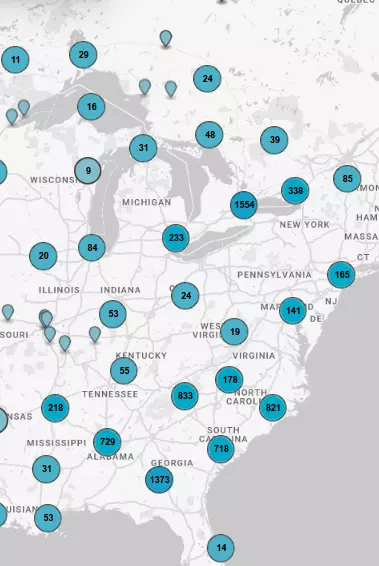Tomlinson Fort House
At this site lived Tomlinson Fort (1787-1859). A leader of the Union Party, he studied medicine and wrote a widely used book on medical practice. A captain in the War of 1812, he served in...
- lat34
Milledgeville State Hospital
In 1837, largely through the influence of Tomlinson Fort and William A. White, the legislature appropriated $20,000 for a dormitory near Milledgeville where the state´s mentally ill could receive...
- lat34
Fort Wilkinson
Three hundred yards east of this point stood Ft. Wilkinson, established in 1797 on Georgia´s Indian boundary. Garrisoned by soldiers whose families lived outside the stockade, it was an...
- lat34
The Rock Landing
Five miles south of this point is the Rock Landing at the head of navigation on the Oconee River and at the junction of the old Indian trading paths leading westward. In 1789 Pres. Washington...
- lat34
Old Oglethorpe University
Hopewll Presbytery in 1833. Its first president, Carlisle P. Beman, was succeeded by Samuel K. Talmage. In 1861, students and faculty entered Confederate service, among them Sidney Lanier. After...
- lat34
The Great Seal of Georgia
When Federal troops entered Milledgeville in November, 1864, Georgia Secretary of State Nathan C. Barnett hid the Great Seal under a house and the legislative minutes in a pig pen 30 yards east of...
- lat34
Old Governor's Mansion
Completed in 1838, The Executive Mansion was the fifth and last resident occupied by Georgia governors when Milledgeville was the capital of Georgia. The Palladian-inspired structure is considered...
- lat34
Old State Capitol
A reproduction of Georgia´s State Capitol 1807-1867 stands on the original site. Wings to the main building were added in 1828 and 1837. Here the Secession Convention met Jan. 16, 1861 and after...
- lat34
The March to the Sea
On Nov. 15, 1864, after destroying Atlanta and cutting his communications with the North, Maj. Gen. W.T. Sherman, USA, began his destructive campaign for Savannah - the March to the Sea....
- lat34
Howell Cobb Plantation
Site of the large Baldwin County plantation of Howell Cobb, one of the ´Great Georgia Triumvirate´ of Stephens, Toombs and Cobb, and his wife, the former Mary Ann Lamar. Born at Cherry Hill in...
- lat34
Provost Guard Campsite
The 3rd Wisconsin and the 107th New York Regiments, having been detailed for provost duty, encamped on this square, November 22-25, 1864. The State Arsenal on the north side of the square...
- lat34
Route of Gen. Kilpatrick's Cavalry
Gen. Sherman´s Cavalry Corps, commanded by Gen. Judson Kilpatrick, consisted of 5,000 men, 8,000 animals, and 300 wagons. It rode from Gordon to Milledgeville on Nov. 24 to join the left wing...
- lat34
Campsite of Union Army
The Union Army of 65,000 men under the command of General Wm. T. Sherman left Atlanta on November 15, 1864. Only the left wing of 30,000 men entered Milledgeville. The advance units arrived here...
- lat34
Junction of 20th and 14th Corps
With the right wing of his army in the vicinity of Clinton and Macon, General Sherman, with the left wing, appeared at this point on November 23, 1864. The left wing, consisting of the 20th and...
- lat34
Cobb's Quarter, Sherman's Campsite
Marching toward Milledgeville via Covington, Shady Dale and Eatonton Factory, the Union Army´s 14th Corps reached this crossroad on the night of November 22, 1864. General Sherman camped at...
- lat34
Route of the Twentieth Corps
On the morning of Nov. 23, 1864, the main body of the 20th Corps of the Union Army, commanded by Gen. A.S. Williams, reached Milledgeville from Eatontaon. The Corps marched down Jackson Street to...
- lat34
Birthplace of Charles Holmes Herty (1867-1938)
Charles Holmes Herty, one of America´s outstanding chemists, was born on this site December 4, 1867. He spent his early life in Milledgeville where he attended the Middle Georgia Agricultural...
- lat34
Battle of Chickasawachee Swamp
Near here in Chickasawachee Swamp a decisive battle of the Southern Indian Wars was fought July 3, 1836. About 300 warriors were entrenched on an island in the swamp, after a raid in which...
- lat34
Baker County
This County, created by Acts of the Legislature Dec. 12 & 24, 1825, is named for Col. John Baker of Revolutionary fame. The original County Site was at Byron but an Act of Dec. 26,...
- lat34
Bacon County
This County, created by Act of the Legislature July 27, 1914, is named for Augustus O. Bacon, four times U.S. Senator, who died in office Feb. 15, 1914. An expert on Mexican affairs, his death was...
- lat34
